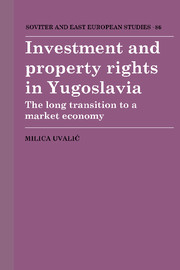Book contents
- Frontmatter
- Contents
- List of figures
- List of tables
- Preface and acknowledgements
- Introduction
- Part I The institutional and theoretical framework
- 1 The Yugoslav road towards market socialism
- 2 The investment theory of the labour-managed firm
- 3 Extensions of the LMF investment theory
- 4 The investment behaviour of the socialist firm
- Part II Empirical evidence on the nature of the Yugoslav system
- Part III Pressure for more radical reforms in Yugoslavia
- Notes
- List of references
- Index
- Series list
1 - The Yugoslav road towards market socialism
Published online by Cambridge University Press: 11 January 2010
- Frontmatter
- Contents
- List of figures
- List of tables
- Preface and acknowledgements
- Introduction
- Part I The institutional and theoretical framework
- 1 The Yugoslav road towards market socialism
- 2 The investment theory of the labour-managed firm
- 3 Extensions of the LMF investment theory
- 4 The investment behaviour of the socialist firm
- Part II Empirical evidence on the nature of the Yugoslav system
- Part III Pressure for more radical reforms in Yugoslavia
- Notes
- List of references
- Index
- Series list
Summary
Despite retaining a communist one-party political regime until 1989, Yugoslavia was the first socialist country to attempt far-reaching economic reforms, and because of its early start and the frequency of systemic changes, it was for years considered the most reformed socialist economy. Along with significant institutional innovation, a policy emphasis on rapid growth led to continuous economic progress up until 1980, when a serious economic crisis began to develop. In order to give an overview of these developments, the evolution of the Yugoslav economic system will be presented through a short description of the main characteristics of past economic reforms, economic performance until 1980, and the present economic crisis.
Past economic ref orms
Each decade in post-war Yugoslavia has brought with it a new series of institutional changes, designed to gradually transform the economy from a traditional centrally-planned one into a more marketoriented system.
For a brief period after the Second World War, the Yugoslav economy was organized along similar lines to that of the Soviet Union. The model adopted was based on centralized planning, state ownership of enterprises brought about through nationalization (except for agriculture, the largest part of which remained in the hands of private farmers), state monopoly in the most important spheres (investment, banking, foreign trade), and administrative control of most prices. The system effectively implied full control of the federal state over the economy.
Following the Tito-Stalin conflict in 1948 and the expulsion of Yugoslavia from Cominform, in the early 1950s the Soviet-type economic model was abandoned.
- Type
- Chapter
- Information
- Investment and Property Rights in YugoslaviaThe Long Transition to a Market Economy, pp. 5 - 16Publisher: Cambridge University PressPrint publication year: 1992



